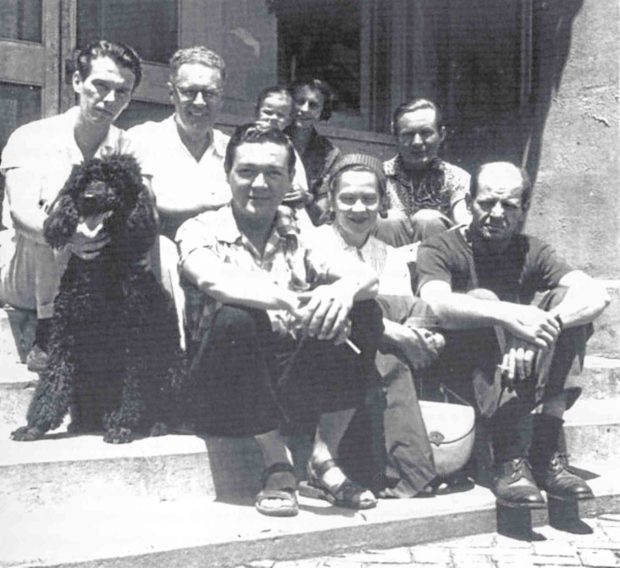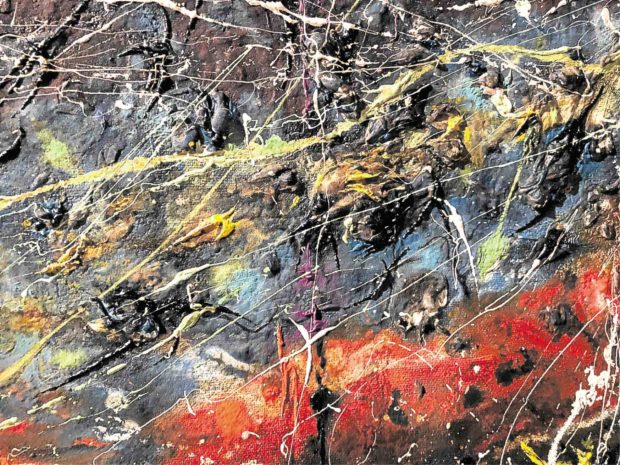

A cryptic oil mural by Alfonso Ossorio that can be viewed horizontally or vertically and bears two titles and is now generally believed a panegyric to his friend, abstract expressionist trailblazer Jackson Pollock, will be bidded out by León Gallery during its Magnificent September Auction next month.
The work, signed and titled twice and dated 1956-1957 (verso or left-hand page), is in oil, enamel and plaster on masonite.
The large-format panel when together is more or less a square. It is titled “Cross-section” when viewed horizontally and “Ascension” when viewed vertically.
The striking work is one of a very limited series made by Ossorio that he gave to very close friends, according to Jaime Ponce de León of León Gallery.
“The unique aspect of this work is that it can be hung either vertically or horizontally with their respective titles,” said Ponce de León, who called it “a tribute to Pollock” because “it was done on the same year that Pollock died in a car crash.”
The auction house owner called the unique work “one of the most important works of Ossorio”: “He only did five of these panels. Two are in the Whitney Museum of American Art in New York City, and the others he gave to the people closest to him.”
“This one was given to his brother Robert Ossorio in 1965,” said the León owner about provenance.
“León Gallery sold one of them in the first-ever exhibit of Ossorio in the Philippines entitled ‘Afflictions of Glory,’ curated by Lilianne Manahan and Lisa Guerrero-Nakpil in 2016.”
The painting bears striking similarity to the drip-works of Pollock and has two dates—
1956 and 1957.
So it appears to have been started before and finished right after Pollock’s death in a fatal car crash on Aug. 11, 1956, while he was on his way to Ossorio’s famous The Creeks, the largest waterfront estate in Long Island, New York.
Now particularly noted for the Catholic sensibility of his prolific oeuvre, Ossorio titled the work “Cross-section” before the crash and “Ascension” right after.
Moreover, dimensions are a form of religious concrete poetry and embody what they mean: they refer to the two dimensions of Christ’s cross (where the phrase “Cross-section” comes from) while the upward element gestures the “Ascension.”
The Philippine-born, British-educated, Benedictine-reared and Harvard-trained Ossorio (1916-1990) is now seen to have held a critical place in United States modern art history, both as dilletante and patron to Pollock and other artists, and as an artist in his own right whose prodigious artmaking ranged from abstract expressionism to the Art Brut of Jean Dubuffet and much later, the Combines-like “Congregations.”
In the Philippines, where he was heir to the vast sugar estate and the famous sugar mill in Victorias, Ossorio is famous for having helped design and construct the St. Joseph the Worker Parish Church in that Negros Occidental town. He also painted the highly dramatic mural that graces the altar, called by Life Magazine in the 1950s as “The Angry Christ,” a name that has stuck and spawned popular lore that may sometimes be misplaced or totally off.
Pollock’s patron
Ossorio’s role in the development of the legendary career of Pollock and the growth of abstract expressionism has lately received recognition in American art history, especially after the publication of the voluminous biography by Steven Naifeh and Gregory White Smith, “Jackson Pollock: An American Saga” (1989), which won the Pulitzer Prize in 1991, and the best-selling social history by Steven Gaines on the East Hamptons where Ossorio held court, “Philistines on the Hedgerow” (1998).
It was Pollock who convinced Ossorio to buy The Creeks, his famous Hamptons estate. Pollock and Lee Krasner, the painter’s now equally famous artist-spouse, stayed there in 1950 when Ossorio returned to the Philippines briefly to supervise work on the Victorias church.

Later in 1950 when Ossorio returned to the United States, he helped Pollock put up the now legendary exhibit at the Betty Parsons Gallery, where the only work that sold was
“No. 1,” purchased by Ossorio himself for P1,500, and which is more known as “Lavender Mist.”
Now hanging in the National Art Gallery in Washington DC, “Lavender Mist” shows Pollock’s drip technique and his “action painting” style that breaks away from the traditional painting of brush, easel and palette, and where the artist is generally “all over” the painting.
Ossorio supported Pollock economically, offering him a $200 monthly support.
He even supported the artist emotionally, since the latter was quite notorious for his mercurial moods, destructive alchoholism and, as the 2000 Oscar-nominated biopic “Pollock” says, “clinically neurotic.”
Ossorio also championed Pollock’s aesthetics. He wrote the essay that appeared in the Betty Parsons Gallery catalogue on Pollock, “Mon ami, Jackson Pollock.”

Pollock, in turn, influenced Ossorio in the latter’s art practice, evident in “Cross-section/ Ascension.”
Ossorio’s influence
But the influence was also two-way.
“We find evidence of Pollock’s influence in Ossorio’s work,” according to the Magnificent September Auction catalogue. “Yet, particularly in the latter years of Pollock’s career, Ossorio, the artist, would play a role in Pollock’s creative practices, as he turned once more toward some form of figurative representation.”
Ossorio painted “Cross-section/ Ascension” right after his Philippine visit and his “wax-and-watercolors period.” He called the phase “a sort of hard-edge period in oil.”
Although the auction catalogue noted that “religious references are a constant in Ossorio’s work,” it also cited Nakpil’s opinion that while the painting may conjure the Catholic teachings of resurrection and redemption, it may also be a depiction of “the more primal if shamanistic impulses of birth and rebirth.”
Whatever the real spirt impelling it, “Cross-section/ Ascension” is significant, said Ponce de León

“There may not be any other figure in the history of abstract expressionism that will loom larger than Alfonso Ossorio,” the León owner said. “Or perhaps, there would not be a Jackson Pollock if not for Ossorio. No doubt their lives overlapped each other. Ossorio played patron, friend and collaborator to Pollock. They certainly lent each other’s mind to cause the move of the ground zero of art from Paris to New York.”
Other works
The auction, said Ponce de León, is in partnership with the Museum of Contemporary Art and Design (MCAD) in line with the 10th anniversary of the latter’s Funding the Future project.
Works donated by Paul Pfeiffer, Mari Taniguchi, Maria Cruz, Nona Garcia, Norberto Roldan, Pio Abad, Poklong Anading and other artists affiliated with MCAD will be sold to benefit the project.
The Magnificent September Auction will be on Sept. 8, 2 p.m., at León Gallery, Eurovilla 1, Rufino and Legazpi Sts., Legazpi Village, Makati City. Catalog access is at www.leon-gallery.com.









































